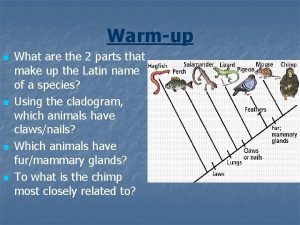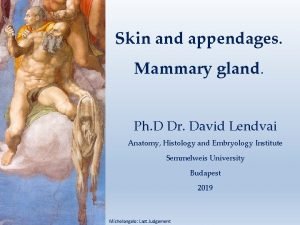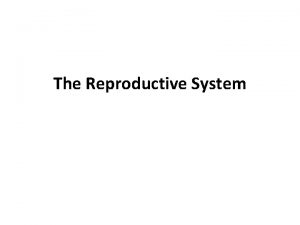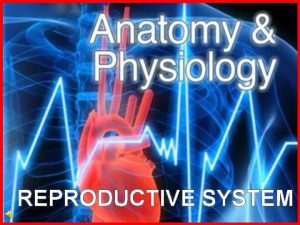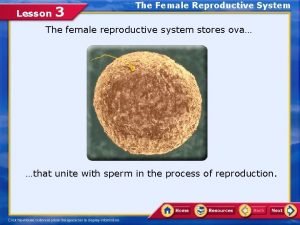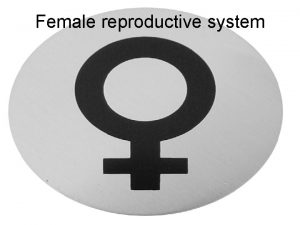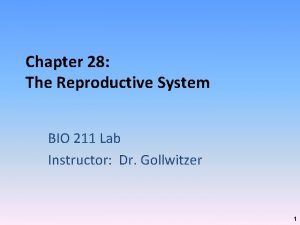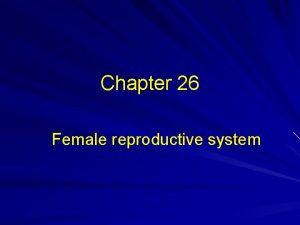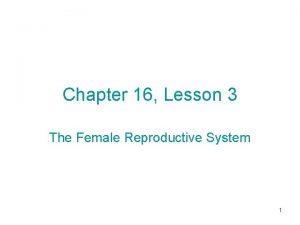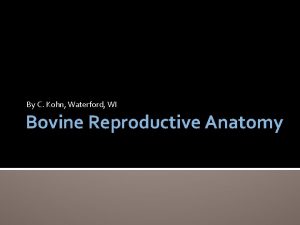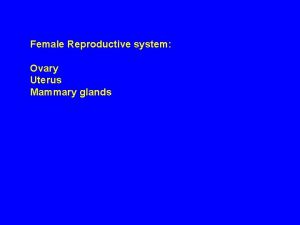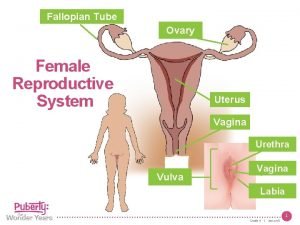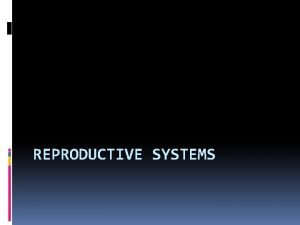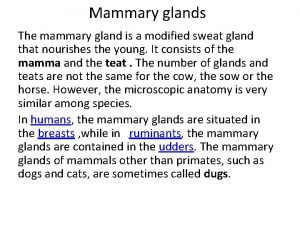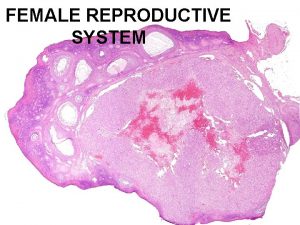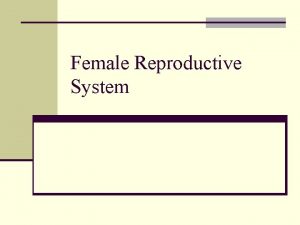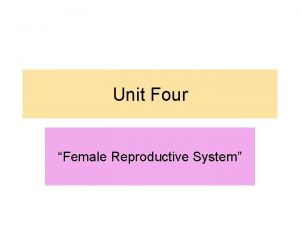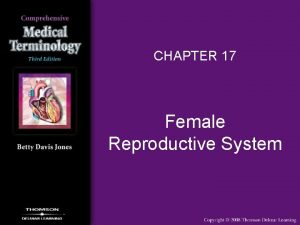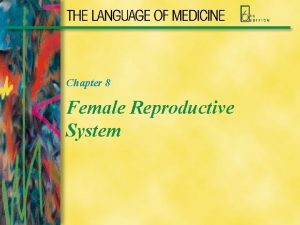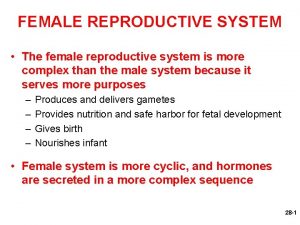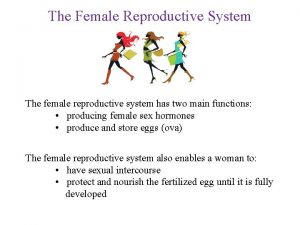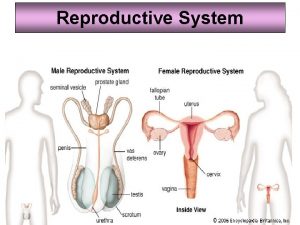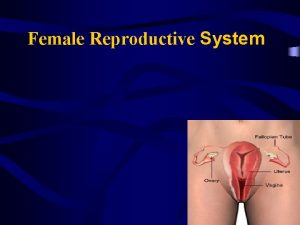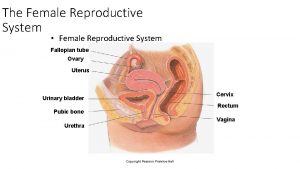Female Reproductive system Ovary Uterus Mammary glands Ovary




















- Slides: 20

Female Reproductive system: Ovary Uterus Mammary glands

Ovary - hormonal regulation - follicular development - Graafian follicle - corpus luteum

Germinal epithlelium Tunica albuginea is DCT and bv

In the Ovary: Stromal tissue Primary oocytes Follicular cells

Ovarian follicles - primordial follicle - primary follicle - secondary follicle - Graafian follicle - corpus luteum

Primordial follicle - primary oocyte (prophase or meiosis I) and simple squamous follicular cells

Primary follicle (unilamellar/multilamellar) - enlarged oocyte (nucleus up to 150 mm) - simple cuboidal follicular cells --> stratified cuboidal --> granulosa cells Activin from primary oocyte granulosa cell proliferation

Primary follicle Zona pellucida – amorphous substance between oocyte and follicular cells - contains follicular cell filopodia and oocyte microvilli. - gap junctions between oocytes and follicular cells Stroma cells: • theca interna -vascularized, have LH rec. secrete androstenedione in response to LH andr. Crosses basal lamina & enters granulosa cells aromatase estradiol released by the granulosa cells • theca externa (fibrous)

Secondary (antral) follicle -FSH stimulates granulosa cell proliferation (and LH receptors on the granulosa cells) -liquor folliculi between granulosa cells àantrum is space with coalesced liquor folliculi With steroid binding proteins, steroid hormones etc. Cumulus oophorus – granulosa cells in the antrum attached to the granulosa cells on the wall Granulosa cells around the zona pellucida remain attached to the oocyte by filopodia corona radiata

Secondary (antral) follicle Some become graafian Most secondary follicles become atretic follicles become interstitial glands Small amounts of androgens

Granulosa cells • • • Nourish oocytes Secrete antral fluid Bind FSH Secrete estrogen, inhibin, Bind LH to start changes that lead of ovulation

Effects of LH • Oocyte, meiosis completion, cytoplasmic changes for implantation (messengers released by granulosa cells) • Increase antral size • Granulosa cells secrete prostaglandings, lower estrogen, prostaglandins breakdown tissue

Graafian follicle: - can see on slide with unaided eye (up to 1 inch) - cumulus oophorus: oocyte +corona radiata + attached follicular cells detach and float in the liquor folliculi LH surge --> increased blood flow to ovaries --> edema (leaking plasma) in theca externa also: completion of meiosis I and then meiosis II --> ovulation and some follicle cells

Ovulation: All of the granulosa cells are making lots of estrogen àHigh blood estrogen àNegative feedback inhibition on FSH from AP AND sudden LH surge from AP 1. Increased blood flow to ovaries --> edema (leaking plasma) in theca externa 2. Around Graafian follicle, histamine, collagenase, PG 3. Completion of meiosis I and then meiosis II --> small region of tunica albuginea looses bl supply àOpening to peritoneal cavity àovulation with some follicle cells

ovulation --> small region of tunica albuginea looses bl supply à Opening to peritoneal cavity à ovulation with some follicle cells à Remaining follicle becomes corpus luteum because LH levels remain high

Corpus luteum: temporary endocrine gland for uterine endometrium Continued high LH Collapse of remaining Graafian follicle --> granulosa lutein cells produce progesterone & convert androgens to estrogen --> theca interna---> theca lutein cells produce progesterone, androgens & estrogen

During Corpus Luteum: High levels of progesterone & estrogen --> LH and FSH secretion inhibited --> lower FSH prevents follicular dev. If pregnancy occurs, placenta secretes human choriogonic hormone (HCG), which maintains the corpus luteum.

Summary of hormonal regulation of ovarian function: Gn. RH FSH and LH Apparently independent of FSH, Activin from oocyte causes proliferation of granulosa cells. FSH multilamellar primary follicles to secondary follicles, - binds onto granulosa cells make estrogen - binds onto theca interna cells make LH receptors

LH: àTheca interna cells make androgens Androgens enter granulosa cells Aromatase converts to estrogen Granulosa cells also make: -inhibin, folliostatin, activin feedback onto AP to regulate FSH release (inhibin inhibits FSH release) Estrogen from granulosa cell àRise in blood estrogen àNegative feedback onto FSH release and Gn. RH release AND stimulates AP release of LH ovulation

LH àGranulosa cells and theca interna cells form CL For 14 days, CL cells -(mostly granulosa-lutein cells) synthesize progesterone -synthesize negative feedback hormones on FSH secretion (inhibin, folliostatin, activin) Progesterone àdev. Of uterine endometrium And neg feedback on LH secretion CL degeneration If pregnancy: Placental h. CG keeps CL secreting progesterone
 Mammels
Mammels Cynocephalus variegatus
Cynocephalus variegatus Cladogram of earthworm trout lizard and human
Cladogram of earthworm trout lizard and human Str papillare
Str papillare Ovary duct
Ovary duct Epithelium
Epithelium Drawing of the male and female reproductive system
Drawing of the male and female reproductive system Female reproductive system with baby
Female reproductive system with baby Ovary structures
Ovary structures Epilization
Epilization Female and male reproductive system
Female and male reproductive system Lesson 3 the female reproductive system
Lesson 3 the female reproductive system Reproductive system
Reproductive system Uterus function
Uterus function Uterus is a part of which system in pila
Uterus is a part of which system in pila Uterus pig
Uterus pig Figure 28-2 the female reproductive system
Figure 28-2 the female reproductive system Female reproductive organs sagittal section
Female reproductive organs sagittal section Chapter 16 the reproductive system answer key
Chapter 16 the reproductive system answer key Female cow reproductive system
Female cow reproductive system Bull reproductive system parts and functions
Bull reproductive system parts and functions


